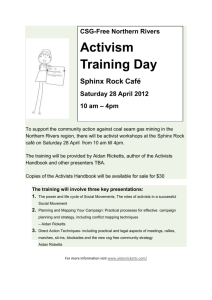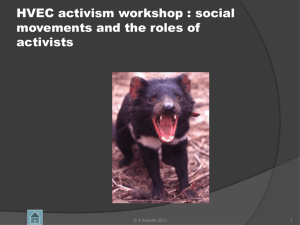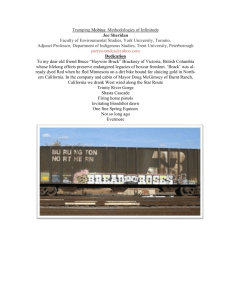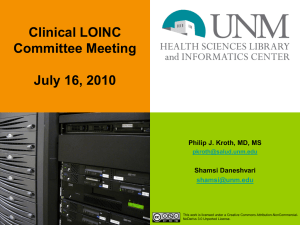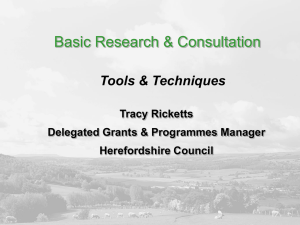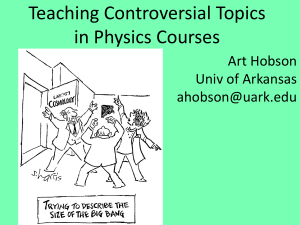Empowerment and Personal Sustainability
advertisement
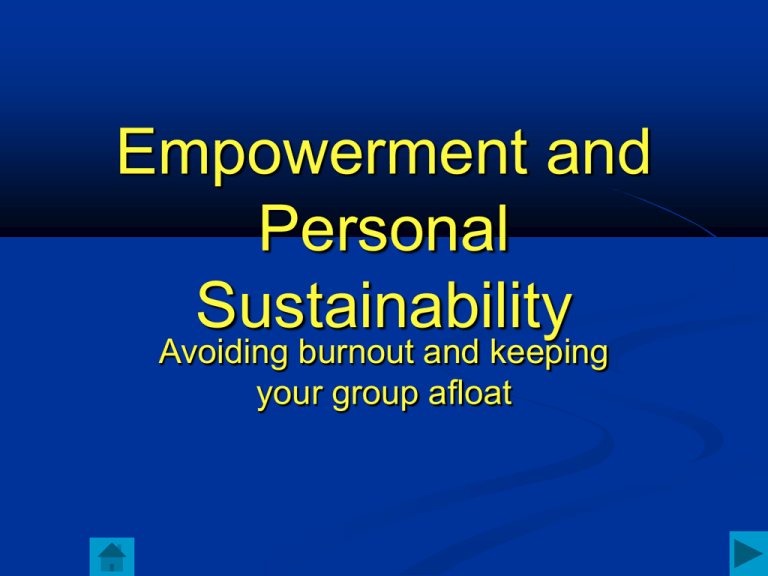
Empowerment and Personal Sustainability Avoiding burnout and keeping your group afloat Personal power and people power Authoritarian (and representative) structures require and encourage personal passivity This habit can be broken by taking action (however small) For some it is forcibly broken by intolerable circumstances For many they take what they see as a small stand on something eminently reasonable and are surprised to become a ‘hero” © A Ricketts 2012 2 Begin to envision The most empowering way to become active is to envision a better future Have you ever dreamed of moving house, having a child, studying for a degree getting a new job, and later found yourself there? Envisioning social change works the same way, it starts with a dream, is informed by practicality and given life by living it. Envisioning is far more sustaining and positive than focussing upon what you oppose. © A Ricketts 2012 3 Hope, empowerment and despair Never doubt that a small group of dedicated people can change the world- in fact it is the only thing that ever has… but remember Social change is a David and Goliath epic Be prepared to both forgive yourselves (for perceived failures) and to congratulate yourselves (for small successes) © A Ricketts 2012 4 Awakening involves dissonance Don’t carry the world on your shoulders Do respect your feelings of smallness , of vulnerability, of sadness Remember: The world may end in catastrophe despite your efforts, but as a human you awaken each day with energy, your choice is about what you do with that energy(no more). © A Ricketts 2012 5 Pacing yourself Humility will help you to expect your path to be long slow one You need to be able to live on the road, so it is important not to place the rest of your life on hold whilst you get on with the project/campaign The truth is that once you become an empowered citizen you will probably have a lifetime of fulfilling projects © A Ricketts 2012 6 The nature of ‘acceptance’ Sometimes it is necessary to first accept the possibility of total failure then to find that place inside you that would still act with hope and integrity Ask yourself, if the world was ending tomorrow would that stop you behaving responsibly towards others? This is where you find that part of you that finds spiritual nourishment from “right action”: “the path with heart” © A Ricketts 2012 7 The importance of fun Social change activities need to be social A fun campaign will be a sustainable , successful and growing campaign Who would want to join your group if you were all permanently depressed? Plan events that are political as well as social: e.g. meetings with bar-B-Qs, volley ball, meetings in nice settings © A Ricketts 2012 8 Building communities Rarely is successful social change achieved from the mammoth sacrifice of single individuals Building communities out of social change organisations assists both personal and group survival The ‘organisation’ needs to consider the personal health of the participants as well as their input. © A Ricketts 2012 9 Creating empowering groups As well as a clear purpose a group must have a healthy interpersonal culture People must feel they belong People should feel safe to bring any level of commitment, information, experience or ignorance to the group Respect diversity , don’t have a template of the ‘right kind’ of person © A Ricketts 2012 10 Choosing appropriate organisational forms Don’t assume incorporation is needed, it may be a waste of resources and encourage hierarchy Alliances can allow other organisations as well as individuals take part Choose a model that suits your size and aspirations Do you need centralised control or a beehive model © A Ricketts 2012 11 Networking with other groups Can avoid re-inventing the wheel Opens up existing networks, experience skills, research Need to overcome inter-group competitiveness and accept difference Create symbiosis between incorporated and unincorporated groups © A Ricketts 2012 12 Dealing with the opposition Try to avoid “thingifying” your opponents, try to keep them human Remember that as well as the “enemy” there may be some ‘ordinary people’ with a different perspective to you Do not assume anyone is an opponent unless it is patently unavoidable Look for a win/win where possible Conflict resolution is valuable but sometimes conflict creation is a precursor to a will to change © A Ricketts 2012 13 Decision making styles: Consensus Consensus is a broad based and well intentioned approach Consensus decision making has the potential to deliver the best decision Consensus can be time consuming If consensus cannot be reached there is a danger of dissenters to be pressured to agree or accused of blocking consensus Need to have fall back deadlock provisions and the ability to record and accept dissent © A Ricketts 2012 14 Decision making: voting Pure majority rule runs the risk of alienating the substantial minority Usually artificially creates a dichotomy between complex ideas Can prematurely decide an issue in a suboptimal way ( a numbers game) Can be useful as a deadlock provision where consensus cannot be reached. © A Ricketts 2012 15 Decision making: affinity groups Very useful for complex direct action. The whole group decides whether an action will go ahead, then the minute planning is delegated to the affinity group who will actually do it Avoids pontificating by those who won’t be active anyway Very empowering for activists © A Ricketts 2012 16 How to structure power within your group There are many ways to structure power Hierarchy is here there are set formal roles But most groups will organically develop those who can lead My favourite model is not hierachy or meritocracy but “activocracy” A model where the most active persons have the most influence simply because they are the most invovled © A Ricketts 2012 17 Meeting facilitation Complex art Do you want everyone to speak equally, or do some people want to be more passive? Free for all, talking stick or a facilitator who controls the order of speaking or break into small working groups and report back © A Ricketts 2012 18 Avoiding Burnout Very common for activists Manifests as depression, exhaustion, chronic fatigue, mood swings, anger, cynicism, emotional freezing, Caused by and feeds into a sense of personal unworthiness compared to the cause “My needs don’t matter” An occupational hazard for those who care © A Ricketts 2012 19 Preventing burnout 1 Do not put life on hold until the campaign is won Do not indulge in the guilt of being human, an oppressor, a white person or a male instead find inspiration in your role as a humble change agent Limit your insatiable appetite for bad news Your health is (at least) as important as every other living thing © A Ricketts 2012 20 Practices for preventing burnout Intentional self nurturing Establish support structures within your organisation Respect needs of your family Let go of results and find your inspiration in the quality of your experience “The people united sometimes win and sometimes lose” (Peavey) Learn to say “Oh what a disappointment” (Peavey) © A Ricketts 2012 21 Forgive and celebrate Forgive yourself and your comrades for failure Celebrate every success (even though you know its not the end of the road yet) Take a breath after each flight of stairs © A Ricketts 2012 22 Resisting internally and resisting externally This is a subtle message but it is important to understand the difference between internal and external resistance Internal resistance is where we don’t accept that the world is the way it is and we make ourselves miserable inside by ‘resisting’ the facts (but im angry because it ‘shouldn’t’ be this way) © A Ricketts 2006 23 External resistance External resistance begins after you accept internally that the world is the way that it is, when you stop making yourself feel bad inside about all the pain destruction and injustice and save all that energy to apply to external resistance External resistance is where you do whatever you can (however small) to bring about positive change © A Ricketts 2006 24 Acceptance is not the same as giving in Accepting that the world is full of pain and injustice (not fighting it inside your body) is not the same as approving of it the way it is, it is just accepting the way things are You don’t have to ever approve of it or give in, but you need to stop victimising yourself about it Then you will be more empowered and have more capacity to engage in meaningful external resistance © A Ricketts 2006g 25 Themes Don’t make your own body or your own happiness the front line between the world as it is and the world as you want it to be Apply yourself to the task of social change in a self loving (and sustainable) way The journey will be long (maybe forever) You may even fail but its still worth it Enjoy it, have fun For most activists, their days of front line action are the best memories they will keep © A Ricketts 2006 26
